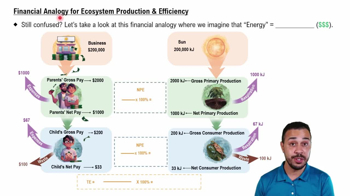Table of contents
- 1. Introduction to Biology2h 42m
- 2. Chemistry3h 40m
- 3. Water1h 26m
- 4. Biomolecules2h 23m
- 5. Cell Components2h 26m
- 6. The Membrane2h 31m
- 7. Energy and Metabolism2h 0m
- 8. Respiration2h 40m
- 9. Photosynthesis2h 49m
- 10. Cell Signaling59m
- 11. Cell Division2h 47m
- 12. Meiosis2h 0m
- 13. Mendelian Genetics4h 44m
- Introduction to Mendel's Experiments7m
- Genotype vs. Phenotype17m
- Punnett Squares13m
- Mendel's Experiments26m
- Mendel's Laws18m
- Monohybrid Crosses19m
- Test Crosses14m
- Dihybrid Crosses20m
- Punnett Square Probability26m
- Incomplete Dominance vs. Codominance20m
- Epistasis7m
- Non-Mendelian Genetics12m
- Pedigrees6m
- Autosomal Inheritance21m
- Sex-Linked Inheritance43m
- X-Inactivation9m
- 14. DNA Synthesis2h 27m
- 15. Gene Expression3h 20m
- 16. Regulation of Expression3h 31m
- Introduction to Regulation of Gene Expression13m
- Prokaryotic Gene Regulation via Operons27m
- The Lac Operon21m
- Glucose's Impact on Lac Operon25m
- The Trp Operon20m
- Review of the Lac Operon & Trp Operon11m
- Introduction to Eukaryotic Gene Regulation9m
- Eukaryotic Chromatin Modifications16m
- Eukaryotic Transcriptional Control22m
- Eukaryotic Post-Transcriptional Regulation28m
- Eukaryotic Post-Translational Regulation13m
- 17. Viruses37m
- 18. Biotechnology2h 58m
- 19. Genomics17m
- 20. Development1h 5m
- 21. Evolution3h 1m
- 22. Evolution of Populations3h 52m
- 23. Speciation1h 37m
- 24. History of Life on Earth2h 6m
- 25. Phylogeny2h 31m
- 26. Prokaryotes4h 59m
- 27. Protists1h 12m
- 28. Plants1h 22m
- 29. Fungi36m
- 30. Overview of Animals34m
- 31. Invertebrates1h 2m
- 32. Vertebrates50m
- 33. Plant Anatomy1h 3m
- 34. Vascular Plant Transport1h 2m
- 35. Soil37m
- 36. Plant Reproduction47m
- 37. Plant Sensation and Response1h 9m
- 38. Animal Form and Function1h 19m
- 39. Digestive System1h 10m
- 40. Circulatory System1h 57m
- 41. Immune System1h 12m
- 42. Osmoregulation and Excretion50m
- 43. Endocrine System1h 4m
- 44. Animal Reproduction1h 2m
- 45. Nervous System1h 55m
- 46. Sensory Systems46m
- 47. Muscle Systems23m
- 48. Ecology3h 11m
- Introduction to Ecology20m
- Biogeography14m
- Earth's Climate Patterns50m
- Introduction to Terrestrial Biomes10m
- Terrestrial Biomes: Near Equator13m
- Terrestrial Biomes: Temperate Regions10m
- Terrestrial Biomes: Northern Regions15m
- Introduction to Aquatic Biomes27m
- Freshwater Aquatic Biomes14m
- Marine Aquatic Biomes13m
- 49. Animal Behavior28m
- 50. Population Ecology3h 41m
- Introduction to Population Ecology28m
- Population Sampling Methods23m
- Life History12m
- Population Demography17m
- Factors Limiting Population Growth14m
- Introduction to Population Growth Models22m
- Linear Population Growth6m
- Exponential Population Growth29m
- Logistic Population Growth32m
- r/K Selection10m
- The Human Population22m
- 51. Community Ecology2h 46m
- Introduction to Community Ecology2m
- Introduction to Community Interactions9m
- Community Interactions: Competition (-/-)38m
- Community Interactions: Exploitation (+/-)23m
- Community Interactions: Mutualism (+/+) & Commensalism (+/0)9m
- Community Structure35m
- Community Dynamics26m
- Geographic Impact on Communities21m
- 52. Ecosystems2h 36m
- 53. Conservation Biology24m
40. Circulatory System
Heart Physiology
Problem 14d`
Textbook Question
During exercise, the cardiovascular system must supply muscles with large amounts of oxygen and fuel and get rid of a lot of waste.
How do the cardiovascular systems of athletes respond to prolonged exercise?
Explain the advantage of the observed difference between current athletes and non-athletes in the graph shown here.
 Verified step by step guidance
Verified step by step guidance1
Understand the role of the cardiovascular system during exercise: It is responsible for delivering oxygen and nutrients to muscles and removing waste products like carbon dioxide and lactic acid.
Identify the physiological adaptations in athletes: Athletes often have a lower resting heart rate and higher stroke volume, meaning their hearts pump more blood per beat, which is beneficial during prolonged exercise.
Examine the graph: Look for differences in heart rate, stroke volume, and cardiac output between athletes and non-athletes during exercise. Athletes typically show a more efficient cardiovascular response.
Explain the advantage: Athletes' cardiovascular systems are more efficient, allowing them to maintain higher levels of performance with less fatigue due to better oxygen delivery and waste removal.
Discuss long-term benefits: Regular exercise leads to cardiovascular adaptations that improve endurance and overall health, reducing the risk of cardiovascular diseases.
 Verified video answer for a similar problem:
Verified video answer for a similar problem:This video solution was recommended by our tutors as helpful for the problem above
Video duration:
34sPlay a video:
Was this helpful?
Key Concepts
Here are the essential concepts you must grasp in order to answer the question correctly.
Cardiovascular System Adaptation
The cardiovascular system adapts to prolonged exercise by increasing heart rate and stroke volume, enhancing blood flow to muscles. Athletes often develop a more efficient system, with a lower resting heart rate and higher cardiac output, allowing for better oxygen and nutrient delivery and waste removal during exercise.
Recommended video:
Guided course

Adaptive Immune Response
Oxygen Utilization and Delivery
During exercise, muscles require more oxygen, which is delivered via the bloodstream. Athletes have improved oxygen utilization due to increased capillary density and mitochondrial efficiency in muscle cells, enabling sustained energy production and performance compared to non-athletes.
Recommended video:
Guided course

Oxygen Requirements for Microbial Growth
Waste Removal Efficiency
Exercise generates metabolic waste like carbon dioxide and lactic acid, which must be efficiently removed to maintain muscle function. Athletes exhibit enhanced waste removal capabilities due to better circulation and respiratory efficiency, reducing fatigue and improving recovery times compared to non-athletes.
Recommended video:
Guided course

Financial Analogy for Ecosystem Production & Efficiency
Related Videos
Related Practice



























![Cardiac Cycle and Conduction System of Heart [Physiology Animation]](https://img.youtube.com/vi/x432O7VhfNU/mqdefault.jpg)







